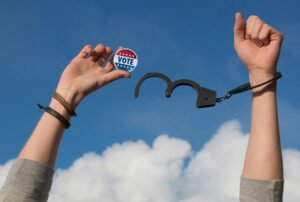
Editors’ note: One of the features of the new news landscape is the single-issue news site organized as a nonprofit. This is something of a response to market failure, and speaks to a need that is very much the business of civil society. Increasing numbers of people see the trend as necessary for balancing and in other ways improving coverage on important issues that should be—but often are not—well reported.
Some examples of such sites are The Trace (devoted to gun control), InsideClimate News, Kaiser Health News, and the Marshall Project (devoted to America’s criminal justice system). These nonprofit news sites tend to be initiated, capitalized, and/or founded by a single large funder. In the case of The Trace, the funder is Michael Bloomberg; David Sassoon founded InsideClimate News; Kaiser Health News was initiated by the Kaiser Family Foundation; and Neil Barsky founded the Marshall Project.
Bill Keller, formerly of the New York Times, made the transition to nonprofit news around a year and a half ago when he joined the Marshall Project—and in this interview with the Nonprofit Quarterly’s editor in chief, Ruth McCambridge, Keller discusses the ideology around that effort. This conversation, besides being an interesting description of an example of this new trend in journalism, addresses the idea of “niche” or “gap” analysis—more simply put, the notion of figuring out “what is missing from this picture” that might advance an effort. The electing of a niche is a high-level strategic act, and it should be revisited often.
This article is from NPQ’s fall 2015 edition, “Making Things Work: Considerations in Nonprofit Strategy.”
Ruth McCambridge: The Marshall Project is one of a number of single-issue news sites that have emerged over the last decade. Can you talk about the idea of the single-issue site and why one is needed for addressing criminal justice at this point?
Bill Keller: Well, at the time that Neil Barsky [the Marshall Project founder and chairman] approached me, which was January of last year, there were a number of things going on relative to this issue. First, it was clear that the criminal justice system was failing to live up to its responsibilities in a number of areas, starting with policing and running the course right through the corrections system. But a significant backlash was developing against current criminal justice policies, and it was a surprisingly bipartisan or bi-ideological backlash, even as media coverage of these issues seemed to have deteriorated somewhat as a consequence of the general trauma that the news business is going through.
To be more specific, a number of newspapers that used to have teams of reporters devoted to investigating the criminal justice system and holding its institutions accountable had turned their attention elsewhere, or downsized, or had even gone out of business. So, criminal justice seemed to be an area where, just when the need was acute for strong journalism, journalism was in remission.
In this context, Neil’s intention was to use journalism to raise a sense of awareness and urgency in the country about the shortcomings of the criminal justice system. We’re not advocates and policy-makers; advocates are the ones who drive actual change, legislation, executive orders, etcetera; but journalism creates the environment where policy-makers and advocates can do their jobs, both by pointing them in the direction of specific problems and by helping to arouse public interest in the subject. In the eighteen to twenty months since we first talked about it, I think there’s been a surge of reinvigorated reporting, certainly among a lot of the national news organizations—the New York Times, the Washington Post, NPR, some of the magazines (the Atlantic and the New Yorker, for example, have devoted a lot more resources)—and somewhat true of the major metropolitan daily papers; and I’d like to think that some of that is stimulated by what we’ve done.
Most of it, however, is the consequence of news, starting with Trayvon Martin, then through Ferguson, and on through this whole litany of mostly black men dying in police custody. There’s been a reawakening of interest in this subject, and a much stronger interest in reform.
RM: People were, I think, surprised when you chose to take on the Marshall Project. What was it about this particular issue that caused you to make this shift?
BK: The decision was based on a combination of personal and environmental considerations. I had been at the Times for thirty years and had had every good job in the place, so I was ready to think about a next chapter. When Neil brought it up, I didn’t immediately say yes. We talked a lot about his vision for the Marshall Project; and then I realized that, as a columnist for the New York Times, I had a job that allowed me to write about anything I wanted to write about, so I decided I’d write a couple of columns on criminal justice issues. I found the subject gripping even just in journalistic terms.
I was shocked by what I had discovered and I also sensed that there was a moment when it was possible that you could actually do some good by shining a bright journalistic light on the subject.
Before that, in one of my columns toward the end of 2013, I had vowed that I was going to stop writing about Washington—where everything was deadlocked and gridlocked and paralyzed—and instead would focus my reporting on states and local governments, where at least it was possible to feel some ferment and change going on on a whole range of subjects. So, I was feeling a sense of frustration about the intractability of Washington, and yet here there was actual bipartisanship. This is the one issue where you have Rand Paul cosponsoring legislation with Cory Booker and the ACLU and the Koch Brothers collaborating on conferences to reform the criminal justice system. And, I thought this could be a time when a well-focused, professional journalistic venture could make a significant difference.
RM: It’s been about forty years since the last really major push was made on a national basis around criminal justice issues in terms of reform. And, despite the fact that the results of policies have been pretty disastrous, the Republican Party has been using the issues as a political football for years. Why do you think all of a sudden we are seeing this coming together?
BK: I think there are two factors in particular at play. One of them is that the crime rate is at or near an historic low. So, in 1994, the year that President Clinton signed his big crime bill—which a lot of people see as the sort of epitome of the tough on crime/lock them up and throw away the key point of view at the time—37 percent of Americans identified crime as the number one issue. By 2012, it was 2 percent. So you’ve had a whole generation that has grown up without the kind of televised urban upheaval—without the crack panic—and polls show that that generation is more open to alternatives to locking people up.
And then along with that there’s been, I think, a significant shift among Republicans. Not all Republicans, and not on all issues, but it’s something that has fascinated me from the moment I began to do my immersion course in criminal justice. This shift among Republicans has a history of twenty-plus years. To oversimplify a bit, it began with evangelicals preaching in prison. The key figure there was Chuck Colson, who spent time in prison himself for the crimes of Watergate. A lot of the evangelicals that he organized to go and preach in prison—to basically try to promote rehabilitation through coming to Jesus—were appalled by the conditions that they found there, and by the fact that the prisons made no effort to rehabilitate prisoners and just warehoused them. So they deserve a lot of credit, I think, for beginning to proselytize fixing the system among conservatives. And they were joined by fiscal conservatives, who saw a tremendous waste of money and lives and human potential.
They, in turn, were joined by Libertarians and small-government conservatives, who saw the criminal justice system as the heavy hand of big government. Grover Norquist, the antitax lobbyist in Washington (who has been supporting some criminal justice reforms for a number of years) talks about how conservatives were against big government but somehow gave a free pass to corrections officers, policemen, and the military; but when you think about it, those are really just government bureaucracies of a different order. In fact, they’re government bureaucracies with weapons.
RM: Never a good thing.
BK: Right. So, Norquist makes the argument that conservatives always criticize liberals for measuring success in inputs instead of outputs. So, is the school system in Massachusetts working well? Well, sure it is, because we spend “X” billions of dollars and we hired all these teachers. And he said when it came to the criminal justice system, conservatives made exactly the same mistake. They said, Well, of course we’re doing everything we can to fight crime, we’re hiring all these policemen, we’re building all these prisons. But that’s just measuring the inputs—it doesn’t measure the success.
And then you add to that good government policy wonks—and Newt Gingrich is the classic example. He got on board early, because he looked at the recidivism rates and said that this is a system that is not succeeding if we let people out—and we do let out 90-something percent of the people who are in prison—and within a few years they’re back again. There’s something wrong here.
So, all of those groups kind of came together, and there were what I guess you would call “demonstration projects.” The state of Texas, when Rick Perry was governor, tried creating some alternatives to imprisonment—drug counseling, diversion of the mentally ill to the healthcare system instead of the corrections system—and they managed to close down three prisons. And then the conservatives could go to other states that were wary of this kind of reformist talk and say, Look, there’s no redder state than Texas, and Rick Perry did this and managed to get reelected. So, it’s politically safe.
One reason that the shift among conservatives is particularly important, I think, is that liberal politicians have been really gun shy. Even while there have been plenty of liberal advocacy groups that have been arguing for reducing incarceration rates (even in the midst of difficult political environments) and making it easier for indigent clients to get a good defense and all of these other issues, liberal politicians were just scared to death that they would be “Willie Hortoned”—pilloried in their reelection campaigns for being soft on crime.
Sign up for our free newsletters
Subscribe to NPQ's newsletters to have our top stories delivered directly to your inbox.
By signing up, you agree to our privacy policy and terms of use, and to receive messages from NPQ and our partners.
This is why you had Bill Clinton supporting the crime bill in ’94, and there are lots of other examples of iconic liberal figures who were just too timid to be out front on issues of criminal justice reform.
RM: Just how vulnerable do you think this new impulse is to a really serious Willie Horton moment or two?
BK: I don’t know. It’s certainly something that a lot of the advocates of these changes worry about. I was talking recently to somebody who works on these issues—it was after those two convicted killers escaped from the prison in upstate New York. And during the period when they were on the loose, a lot of advocates were sitting on the edges of their seats, nervous about the possibility that these guys would commit some horrible atrocity that would set back the cause of reform for years. I’ve talked to others who think that the national mood is such that it would take more than one or two bad episodes to kill off the reform movement. I don’t know, we will see. I mean, there will inevitably be such episodes, and to some extent it depends on how eager politicians are to exploit them.
But there are other ways that this bubble could burst. I can imagine, for example, Congress passing a piece of legislation that’s pretty much watered down to nothing—with only a few elements of comprehensive criminal justice reform—and then declaring “mission accomplished” and moving on to other things, and the movement sort of loses momentum. As a nation, we sometimes tend to have a short attention span.
RM: As you said, there was a huge momentum for at least police reform coming out of Ferguson and other incidents—all of which have been happening all along but at this point get highlighted for some reason. But how do you think this kind of movement to reform the criminal justice system will deal with the questions involving race and poverty that are inherent in the criminal justice system? Or will it just kind of steer clear of that?
BK: That’s a really interesting question, because the criminal justice system is so suffused with questions of race. You know, 40 percent of the 2.2 million Americans who are in prisons or jails are African American, roughly, and I think another 19 percent are Latino. Race is at the heart of some of the literature that has helped build this movement, most noticeably Michelle Alexander’s The New Jim Crow, but also Bryan Stevenson’s recent book [Just Mercy].
It’s very hard to talk about these issues without acknowledging the disparities of the consequences for minorities and the poor. They’re not only the source of the criminals; they’re the source of the victims. I mean, it’s the poorest communities that tend to be the most victimized by crime—and they’re the ones that get torn apart when such a large percentage of the young men are locked up. And they’re the ones that pay the price for our lack of rehabilitation, so that young men go into prison, do their time, and if they learn anything it’s likely to be about the brutality of life. They’re given those skills and then they’re dropped back into the same communities they came from, which just exacerbates the problem. So, it’s a sort of vicious cycle.
The racial aspect of it makes the conservatives who are embracing these issues pretty uncomfortable. The people that I know on the right who advocate criminal justice reforms will say that obviously this is important to do because it disproportionately harms communities of color; but they don’t want to talk about racism as a factor in the creation of the problem. They tend to think that it’s just divisive and alienating to say that we’re all a bunch of racists because we did this. “Let’s leave motives aside.” We hear that a lot from conservatives.
RM: Over the past couple of weeks, there has been a resurfacing of discussions of bail and the unfairness of bail systems. Are we going to just cycle through the probably dozens of different aspects of bad policies in the criminal justice system and somehow wind up at some point with a set of policies that will be pushed at the federal level? Or, is the action going to take place more at the state level and then filter up? How do you imagine this really rolling out?
BK: I should probably preface this by saying I don’t really know because I don’t have a crystal ball—but my guess is that there will be a push between now and the end of the year at the federal level to do something. It would mostly have to do with lowering mandatory minimum sentences for nonviolent offenders, particularly in the area of drugs. It may or may not pass, but there will be a concerted effort, and it will be discussed in the presidential campaign more than anybody might have anticipated a year ago. But whether or not the federal government enacts meaningful change, the states are going to continue to be laboratories for different ways of approaching these problems—and something like 90 percent of the incarcerated population is in state prisons and county jails. And there you have the cycle you referred to. The cycle of bad policies is being challenged by a cycle of the reform experiments. Places like the Vera Institute and the Pew Charitable Trusts are funding and staffing reform efforts in states and counties.
On the question of bail, by the way…one of our reporters has just been down in Kentucky, which basically did away with private cash bail—the bail industry—and has tried to use risk-assessment tools and alternatives to curtail the practice of basically locking people up because they are too poor to pay bail, except in cases where somebody seems to represent a threat. She’s just back, and she will write up that experiment, but I think the general conclusion will be that while the results aren’t perfect, there does seem to be a reduction of that problem of essentially creating debtors’ prisons. So, while much of our work at the Marshall Project has to do with pointing out things that are egregiously wrong with the system, we’ve tried to focus a light, too, on places where people are doing something different that seems to be working.
RM: During the ’70s, I was very active in these issues, and there was a lot of laboratory stuff going on. The whole deinstitutionalization movement got traction and then pretty much blew itself out through lack of investment in alternatives. To what extent are we going to be able to understand what it’s going to take on the other side even if we are successful in depopulating the prisons and pulling people out who, for instance, have mental health issues? To what extent are we going to be able to answer the need that emerges from all of that?
BK: Well, I think you put your finger on the biggest single question about whether this moment turns into a movement or just bursts, and I don’t think we know the answer to that yet. I mean, people are, I think, generally aware that the alternatives to prison aren’t free.
Joan Petersilia at Stanford Law School, who’s somebody I and other reporters here talk to from time to time, uses that very example of Kennedy’s deinstitutionalization program for closing down the warehouses of the mentally ill and sending people to their communities where they could get more humane, sympathetic treatment. But they didn’t provide enough funding to build the places that were supposed to take them under their wing in the local communities. And to some extent you’re getting a whiff of that happening in California. California is about five years ahead of the other states, because they’re under a Supreme Court order to reduce prison overcrowding, and they have reduced their state prison populations by something like 25 percent. But a number of the advocates at the county level say that there hasn’t been enough of the money needed to provide the alternatives.
There’s definitely been some investment in mental health centers and drug addiction programs, but the question is whether there’s enough. It’s the question that I always ask the conservatives particularly, because a lot of them are drawn to this issue as the prison system costs so much. I always ask, Are you going to find a constituency that’s willing to spend the money to do the alternatives? And, they’re aware. In November [2014], California passed Proposition 47, which reduced a lot of crimes—especially low-level drug crimes and shoplifting, and things like that—from felonies to misdemeanors; and that bill included a provision that a significant percentage of any savings that resulted from reduced prison populations had to be funneled into alternative corrections programs.
So everybody is more or less aware of the mistakes that happened when they shut down those warehouses for the mentally ill, and that the mistake should not be repeated; but whether they’ll actually have the fortitude to [fund the alternatives] is an open question.
RM: In a way, it’s frightening, because you want the advocates to be discussing these things well ahead of time so that people don’t back off and say, I didn’t know it meant that!
BK: Well, I don’t want to sound like a Pollyanna—I do see the potential failure of this undertaking. But one other thing that is encouraging is that a lot of philanthropy is being pumped into reform efforts of both the advocacy groups and the local governments that are experimenting with new ways of doing things. The Marshall Project has been the beneficiary of this sort of new awareness (or keener awareness) on the part of foundations and individual philanthropists that it’s going to take a sustained effort to make change—it’s not going to happen overnight.
RM: Which philanthropic institutions do you see really stepping forward at this point?
BK: Ford, MacArthur, the Arnold Foundation, and a number of others.
RM: The Arnold Foundation is regarded as relatively conservative.…
BK: Yes, relatively conservative…run by a husband-and-wife team who make their own decisions. The head of their New York office is a former attorney general of the State of New Jersey, who’s extremely knowledgeable on things like risk-assessment tools. So, I’ve had some firsthand experience of their expertise and the way they’ve chosen to spend their money, and they’re pretty impressive.
But you know, I guess my biggest fear is that this moment will come and go—that it will be a moment, and not a sustained effort; that we will be distracted by some other bright shiny object, and that the air will go out of the balloon. This is going to sound hopelessly promotional, but it’s why, I think, you need a place like the Marshall Project. I’m sure places like the Vera Institute and the Innocence Project will stick with this issue whether the public is clamoring for it or not, but they stand a much better chance of accomplishing something if the public has this subject on their minds—which is where journalism comes in.












